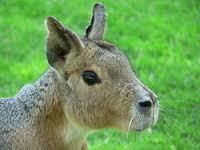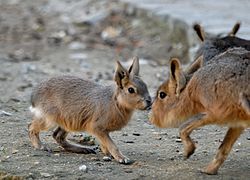The Patagonian mara, is a relatively large rodent in the mara genus (Dolichotis). It is also known as the
Patagonian cavy, Patagonian hare or dillaby. This herbivorous, somewhat rabbit-like animal is found in open and
semi-open habitats in Argentina, including large parts of Patagonia. It is monogamous, but often breeds in
warrens that are shared by several pairs.
Social behavior and reproduction
The social organizations have a unique combination of monogamy and communal breeding. Being monogamous, pairs
of maras stay together for life with replacement of partners only occurring after its death. The male has almost
the sole responsibility in maintaining the pair by following the female wherever she goes. A male will mark his
female with urine and mark the ground around her with secretions from his glands and with feces, making the
grounds around the female a mobile territory. Pairs will breed together alone or with other pairs in warrens
shared by up to 29 pairs. Maras breed, at least in southern Argentina, from August to January. Gestation lasts
100 days in wild. Most births in Patagonia occur between September and October which is before the summer dry
season and after the winter rains. Female produce one litter each year in the wild, but can produce as many as
four litters a year in captivity. Young can walk almost immediately postpartum.
Dens are dug during the breeding season for the young to be raised. Litters from 1-22 pairs are grouped together
in these dens. Communal living provides protection from predators with the survival rate for young being higher
in larger groups than in smaller groups. One pair visits the den at a time for around one hour and the other
parents will circle around the den. 1-2 pups are nursed at a time by a female. A female may sometimes nurse a
young from another pair. While a female may prevent young other than her own from nursing her, some young are
able to steal milk. Mothers do not actively cooperate in raising their young. For the first three weeks, young
remain near the den. At this time there is low inter-individual distance, frequent body contact, huddling,
allogrooming and extended play among the pup. After this, the young are able to leave the den and graze with
their parents. Young are weaned after 13 weeks.
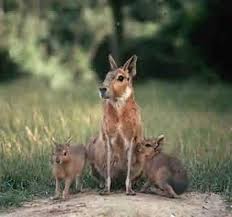
Maras will make a number of vocalizations during grazing or slow locomotion. When seeking contact, a mara will
emit an inflected wheet while a low repetitive grunt is made when following a conspecific. Mara tooth chatter
and emit low grunts when threatened. They also produce a series of short grunts when grooming. Scent marking is
used by maras for complex and intense social interactions. Maras will stretch and sniff the soil and then sit
upright with an arched back and the anogenital area flattened to the ground, a process known as anal digging.
In addition a male will stand on his hind legs and urinate on a female’s rump to which the female will respond
by spraying a jet of urine backwards into the face of the male. The male’s urination is meant to repel other
males from his partner while the female’s urination is a rejection of any approaching male when she is not
receptive. Both anal digging and urination are more frequent during the breeding season and are more commonly
done by males.
Ecology and activity
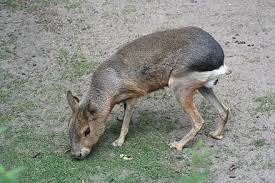
The Patagonian mara is found only in Argentina. It ranges from 28ºS to 50ºS. Maras prefer to live in habitats
with lots of shrub cover. However they also inhabit overgrazed and barren soils in the Monte Desert biome.
In northwestern Argentina the mara primarily inhabits lowland habitats like forest and creosote bush or larrea.
Maras prefer sandy and low shrub habitat in Valdes Peninsula. It has adapted well to a cursorial lifestyle on
the open plains and steppe, with its long legs, reduced clavicle and well-developed sensory organs making it
capable of running and communicating in these open habitats. When running, maras have been compared to deer and
antelope. Maras are largely herbivorous. They feed primarily on green vegetation and fruit. In the Monte Desert,
monocots make up 70% of its diet while dicots make up 30%. Preferred grass species eaten are those of the
genera Chloris, Pappophorum and Trichloris while dicots that are eaten include Atriplex lampa, Lycium and
Prosopis.
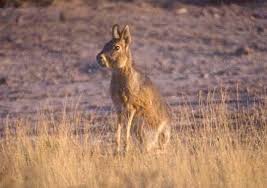
Maras are primarily diurnal and around 46% of its daily activities involve feeding. The temporal activity
rhythms of maras are related to environmental factors. Light, precipitation and temperate have a positive
effect on annual activities while darkness and relative humidity have a negative effect. The daily activity of
the mara is unimodal in winter and biomodal in other seasons. The preferred temperature of the mara is around
20 °C (68 °F)C. Females spend more time feeding than the males, due to the demands of gestation and lactation.
Males spend most of the day sitting, being vigilant for predators. Predators of maras, particularly the young,
are felids, grisons, foxes and birds of prey. Mara are also hosts for parasites like the nematode worm
Wellcomia dolichotis.
Conservation status
Near threatened
The Patagonian mara is considered to be a near threatened species. Historically, maras have ranged from
north-central Argentina south almost to Tierra del Fuego. Nevertheless, maras have been greatly affected by
hunting and habitat alteration and have been extirpated in some areas including Buenos Aires Province. The
mara skins have been used for bedspreads and rugs.



